
How to Create the Perfect User Guide + Templates


Customer experience used to be all about person-to-person interactions.
Now customers are more demanding; they want quick solutions or fast response times. That’s why self-service solutions like user guides are becoming the go-to option.
Surprisingly, many customers love them too. In a recent Digital First Customer Experience Report, 81% of users admit they want more self-service options.
The reality is that user guides are no longer “nice to haves”—they are invaluable resources that empower users to maximize the full potential of your product.
In some industries, providing user manuals for products is not just best practice; it’s a requirement by law.
Beyond legal compliance, creating a user guide can actually save you money by reducing support costs while also enhancing the overall customer experience and increasing product adoption.
In our complete guide, we’ll show you how to create a compelling user guide that provides guidance and support to end users. We’ll also provide real-life examples you can learn from, along with customizable templates and tools to get your user guide off the ground quickly.
A user guide is a document that provides users or customers with detailed instructions on how to perform a task or use a product. It covers detailed information about operations, standards & guidelines, troubleshooting guides and functionalities of a product or system.
A typical example is the handy manual that comes with a new physical product, such as smartphones, electronics or appliances. Digital products or software also have user guides in various forms, such as interactive in-app walkthroughs, video tutorials, help guides, PDFs and video tutorials.
User guides are important for several reasons. They fill in knowledge gaps, making it easier for users to maximize or integrate your tool into their daily workflow.
Creating a user guide can also deflect a significant number of basic support inquiries. Users can troubleshoot problems themselves or find answers to their questions within the guide—without help from your support team.
Ultimately, a well-written user guide leads to a smooth learning curve, fewer support inquiries and a positive user experience.
People often mix up both terms. While searching for a user guide or manual, you may even come across terms like technical documentation, maintenance guide, quick start guides and instructional guide.
But, there’s a subtle difference between a user guide and a user manual.
A user guide is designed for everyday users, so it’s concise and easier to understand. It focuses on getting users started with the product and contains step-by-step instructions, FAQs, examples, usage tips, troubleshooting advice and general information to help users maximize their product experience.
A user manual, on the other hand, is a more detailed document that can serve as a reference for both end-users and technicians.
It dives deeper into the technical aspects of a product, including the specifications, installation instructions, maintenance procedures, troubleshooting steps, safety warnings and legal information. Some user manuals may also cover aspects like firmware updates and advanced configuration.
Made with Visme Infographic Maker
If you run a customer-centric organization, you probably understand why it’s a good idea to create user manuals. It just makes life easy for your customers, which is a good thing. They’ll keep coming back and most likely rave about your brand.
But customers aren’t the only ones who benefit from these valuable resources. Let me break down the benefits for both customers and your organization.
1. Ease of Use: A user guide breaks down complex processes into clear, easy-to-follow steps. This helps users feel more confident and less frustrated when using your product.
2. Faster Onboarding: With a structured guide in hand, users can quickly learn how to set up and use the product. It removes the guesswork and shortens the learning curve. Users don’t have to search everywhere for information or wait for assistance.
3. Fewer Errors: Step-by-step instructions reduce the chance of user errors. That means less confusion and a better first impression of your product.
4. Self-Service Support: Users don’t have to rely on support for every little issue. They can troubleshoot and solve problems on their own by flipping through the guide.
5. Better Experience: When customers know how to get the most out of your product, they’re more satisfied. And satisfied customers are far more likely to become repeat buyers and vocal advocates.
1. Reduces Support Load: A thorough user guide answers common questions before they become support tickets. This allows your customer support team to focus on more complex and urgent issues.
2. Increases Product Adoption: Users who understand the full value of your product are more likely to explore and use its features. This deepened engagement often translates to long-term usage and success.
3. Strengthens Brand Credibility: A well-crafted user guide signals professionalism and care for the customer. It shows that your company is committed to helping users succeed.
4. Improves Customer Retention: When users have a good experience from the start, they’re more likely to stick with your product over time. This long-term satisfaction drives renewals, repeat purchases, and customer loyalty.
5. Minimizes Risk: Proper usage instructions help reduce the chance of misuse, which is especially important for technical, safety-sensitive or regulated products. This protects both the customer and your brand from avoidable issues.
A user manual is a crash course that allows users to achieve faster time to value and high adoption rates for your product. It comes packed with helpful documentation that equips customers with the essentials to get started and use the product effectively for most common tasks.
Although every product is unique, below are key elements that should be included in a good user manual.
Other things to keep in mind when creating a high-quality user manual:
User manuals come in various forms, each covering different topics and tailored to a specific purpose and audience.
Let’s explore some of the common types, along with examples and templates.
An instructional manual introduces a product, explains how to set it up and the different ways it’s used, along with step-by-step tutorials for each application. It also often features troubleshooting sections to help users resolve common issues they might face.
Below is an example of an instructional manual for a Canon camera.
Training manuals are another type of user guide that’s valuable for internal and external use.
Within your organization, you can use it to onboard new employees, update employees on new procedures or technologies or provide a reference guide for complex tasks.
Training manuals can also be used externally. For example, companies can create instructional booklets, education guides and documentation to show customers how to use specific tools or features to improve business results. Organizations also provide training manuals to external partners, vendors or suppliers to ensure consistency in quality and practices.

This type of user guide provides comprehensive information on how to maintain, service and repair a product or equipment.
Technicians, engineers or service personnel typically rely on service manuals to understand the inner workings of a product, troubleshoot issues and perform necessary repairs or maintenance. So you’ll often find detailed diagrams, technical specifications, troubleshooting procedures, maintenance schedules and information about replacement parts in this type of manual.
Below is an example of a maintenance and service guide for an HP Pavilion Gaming 16 Laptop PC.
An operation manual provides instructions on how to operate a piece of equipment, a tool, a machine or a system. It typically includes information on the installation, setup, use, maintenance and troubleshooting of the system.
Operation manuals guide users in safely and effectively using the product or equipment according to the manufacturer's guidelines and can help prevent accidents and damage.
Here’s an example of an operational manual for a Coca-Cola Freestyle dispenser.
A standard operating procedure manual outlines detailed, step-by-step procedures for carrying out routine operations within an organization. It’s crucial for standardizing processes, training new employees and ensuring that tasks are executed in an organized manner.
While operating manuals are product- or system-specific, SOPs cover various aspects of business operations, processes and procedures across different departments or functions.
For example, an organization may have different SOP manuals for HR, financial management, sales and marketing, IT and data management, safety protocols, quality assurance procedures, etc.

How-to guides are created as instructional resources to walk users through performing specific tasks or activities. They help users understand and complete a particular process, such as assembling a product, using a software feature or troubleshooting a technical issue.
For example, in-app tutorials and user guides are commonly used in SaaS platforms to help users navigate their processes and workflows. These guides typically include detailed explanations, visual aids, tutorials and tips on how the product works or how features can be used.
In-app walkthroughs are a guidance feature within a mobile app or software that provides real-time support and instruction to users as they navigate through the application.
In-app guidance can include interactive walkthroughs, tooltips, screen overlays, pop-up messages or contextual help that appears at relevant points within the app. This type of user guide effectively provides targeted, just-in-time support when users need it most—they don’t have to leave the interface or search for help in external documentation or contact support services.
A knowledge base is a central hub of information that shares comprehensive resources and solutions about a product or service. It includes educational content such as support and how-to articles, product guides, tutorials, manuals and frequently asked questions.
Knowledge bases are typically organized into categories and subcategories so that users can quickly navigate and locate relevant information. Users can access this self-serve repository to troubleshoot issues, learn about new features or find answers to common questions.

Here’s a visual summary of the types of user manuals, their primary use cases, and when to use each one:
| Type of User Manual | Primary Use Case | When to Use It |
| Instructional Manual | Explains how to set up, use, and troubleshoot a product. | When launching a product and you want to ensure customers know how to use it properly. |
| Training Manual | Onboards users (internal or external) with guided learning and tutorials. | When training employees, partners, vendors, or customers on tools, systems, or processes. |
| Service Guide | Provides detailed maintenance, repair, and technical specifications. | When technicians or service professionals need to fix or maintain equipment. |
| Operation Manual | Offers instructions for operating a product or system safely and effectively. | When you want to ensure proper day-to-day usage of machinery, tools, or systems. |
| SOP (Standard Operating Procedures) Manual | Outlines repeatable processes and company-wide procedures. | When you need to standardize internal processes across teams or departments. |
| How-to Guide | Walks users through a specific task or function. | When users need quick, focused help on completing a task (e.g., installing a plugin or updating a field). |
| In-App Walkthrough | Provides contextual, interactive support inside an app or software. | When onboarding or guiding users through software interfaces in real-time. |
| Knowledge Base | Houses all documentation, guides, FAQs, and tutorials in one searchable place. | When you want to provide a self-service help center for users to troubleshoot and learn independently. |
Now that we’ve explored different types of user guides, let’s see what they look like in action with these real-life examples:
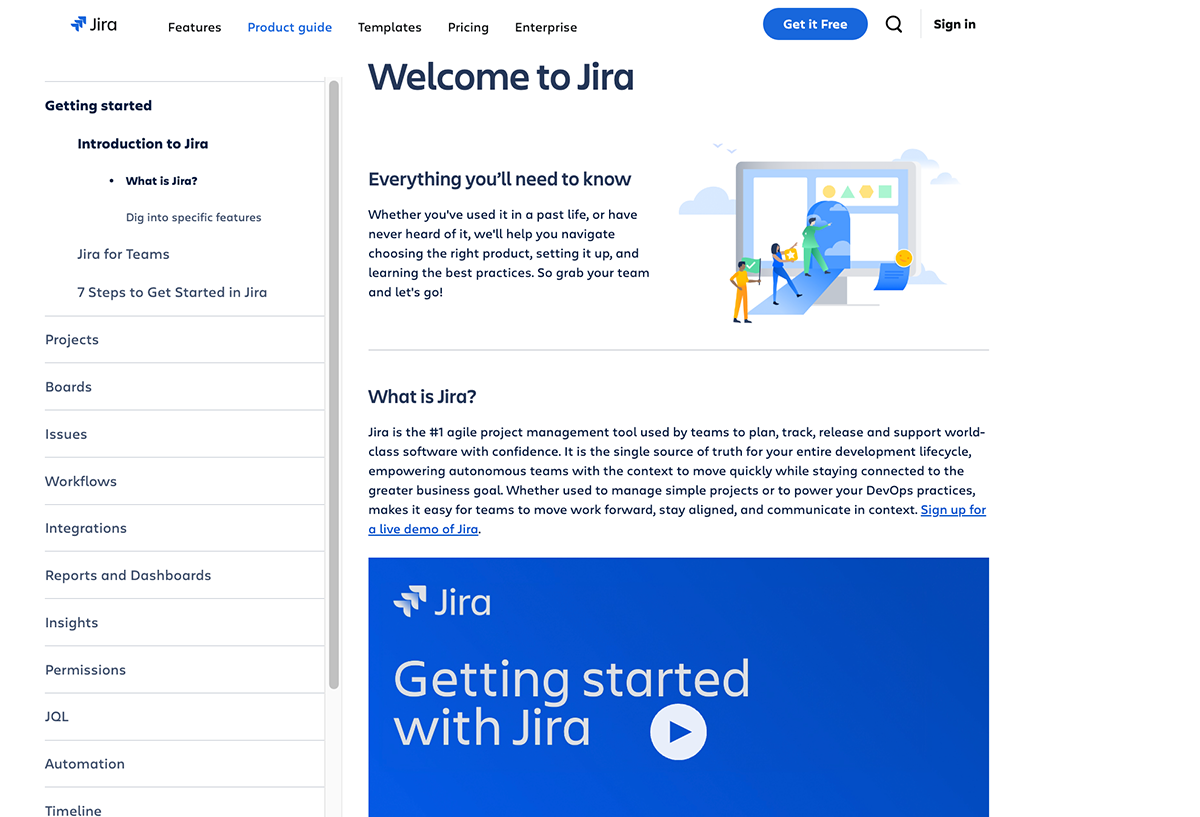
Jira's product guide is a shining example of a user guide done right. The product guide nav sits right next to features on their homepage, so users can easily access it.
What sets this guide apart is how well-organized the information is. The table of contents is neatly aligned to the left with visible sections, subsections and bullet points, making it easier for users to follow the documentation step by step.
The guide begins with an introduction to the product and an overview of its features. As users progress through the guide, they are gradually introduced to more advanced features. Plus, the guide maintains a simple and user-friendly tone, ensuring that users with varying technical backgrounds can easily follow along and learn.
As you dive into each section of the product guide, you’ll find hyperlinks, text blocks, screenshots and videos that make the content visually appealing and easy to digest. The videos and screenshots not only provide an immersive demo but also allow users to visualize the step-by-step process.

Notion offers another incredible example of user guides to learn from. They have a detailed help page split into three key segments:
Each of these high-level segments has sections and subsections covering a wide range of topics, from getting started to advanced features like Notion AI, Calendar and Sites.
Notion's user guide is sprinkled with unique hand-drawn images, diagrams, icons, screenshots, GIFs and videos.
They've also used brief paragraphs, text blocks and bullet points throughout, which make for an easy read. Plus, the language is simple, which makes it professional but friendly.

Visme provides users with an extensive collection of in-app walkthroughs and tutorials split into three main parts:
For users new to the platforms, there’s an interactive product and quick reference guides that open directly in the Visme editor. These guides combine brief text with beautiful designs and GIFs, so users can read, interact with and practice some of the learnings in them right within the Visme editor.

Help Topics cover a whole bunch of topics, such as the basics, design and editing, tips and tricks, productivity tools, forms and surveys. Each topic has multiple subsections, so you’re likely to find everything you need to know about the software.

Now here’s the best part. Within the tool, Visme also provides bite-sized videos on various topics, such as account settings, brand management, data visualization, presentation, interactivity, teams, workspaces, etc.

These videos excel at showing users exactly what to do at the right time within the app, leaving no room for confusion. And since they are short, sweet and fun, users will feel motivated to watch them to the end.
Creating a user guide is an investment in your users' success and your brand's reputation.
When done right, it can make a difference for your business and the client you are looking to serve.
We’ve broken down the process of writing a user manual with Visme into easy-to-follow steps.
The first step you should take is to identify the primary users of your product or service.
What is their level of technical expertise—beginner, intermediate and advanced? Are they familiar with your product or service? Do they have prior knowledge of the basic features and need help upgrading to the premium features?
It’s also crucial to set goals when writing a user guide. What do you want users to get out of the guide? Is it to learn basic functionalities, troubleshoot problems or explore advanced features?
A user guide for beginners will differ significantly from one for experienced users. So, this analysis helps you create a clear path to success for users.
When creating a user guide, it's important to gather all relevant information about the tool or product. This may include features, functionalities, specifications and common issues that users might face.
To get more insights into common pain points, consider gathering feedback from beta testers, early adopters or customer support to understand users' product experience.
Use Visme’s interactive feedback form creator to build and publish interactive feedback forms with a link or QR code or embed them on your website using auto-generated HTML.

Even if you have existing manuals, this might be a good time to do a full content audit to identify areas where improvements might be necessary. You can also look at competitor manuals and industry standards to get ideas and best practices.
Process mapping and user journey mapping are critical steps you shouldn’t overlook when creating your user guide.
Start by visualizing and documenting the steps users will take to use the product or service.
Mapping out the core activities and processes involved in using your product lets you cover all the essential information for users to complete tasks successfully.
It also reveals potential bottlenecks within the product's workflow (which can be addressed with instructions or troubleshooting tips).
Visme offers dozens of flowcharts, process flow and diagram templates that you can use for this task.
Here’s a customizable process flow template to get you started.

Read the articles below to learn more about process mapping, workflows and documentation.
Visualizing the user journey map is the other important piece of the puzzle. It lets you see things from the user's perspective and understand how they're interacting with your product or brand.
By mapping out the user's journey—from initial awareness to product use—you gain valuable insights into their goals, needs and potential frustrations across multiple touchpoints.
Get started with the template below or visit our library to discover a variety of user journey map templates you can use.

When you overlay the user journey map on top of the process map, you can ensure nothing is overlooked. It gives a complete picture of the steps, decision points and problems users will encounter with your brand.
Both frameworks empower you to create a more detailed, intuitive and user-friendly guide.
Pre-built templates give you a creative head start and save time that would have otherwise been spent designing your user guide from scratch.
Besides the attractive design, these templates organize your content in a logical sequence that matches how users interact with your product. Plus, they include a table of contents, clear headings and subheadings that make navigation easy for users.
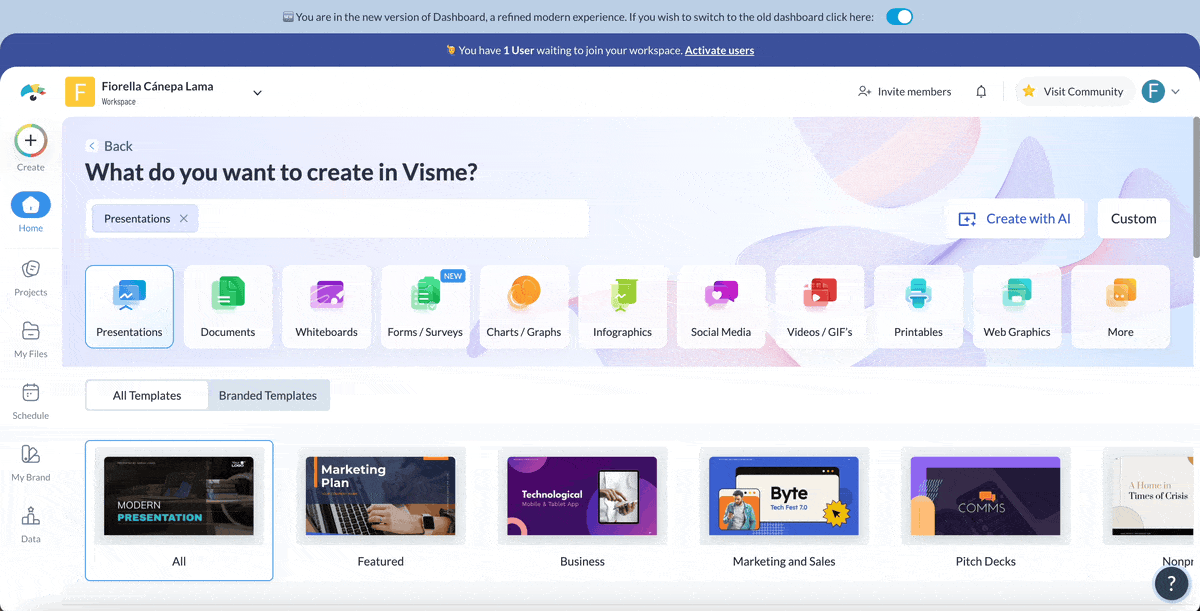
To get started, create a new account or log in if you already have one. Once you’re in, you’ll find a beautiful dashboard packed with all the amazing features you’ll find in powerful visual design software.
Next, search the Visme library for the right template. You’ll find templates for creating documents, presentations, PDFs, explainer videos, demos, training manuals, job aids and interactive walkthroughs.
Simply click Create New > Project and then use the search bar to quickly find the specific type of user guide template you need.
Preview the template or click "Edit" to start customizing it. You can also begin your design from scratch and increase the canvas size to match your preferred size.

The next step is to swap out the filler text with your own. When writing your copy, keep the user's perspective at the forefront.
Provide an overview of the user guide, purpose and what users can expect to learn. Begin with basic functionalities and gradually introduce more advanced features as the user progresses through the guide.
Explain each step using concise, plain language—write as if you are speaking with a layperson and avoid technical jargon unless necessary.
Break down tasks into clear, step-by-step instructions. You can use numbering or bullet points for easy readability. White spaces can also improve readability and prevent users from being overwhelmed with text.
If you need help getting your content off the ground, our AI text generator can help.
Just input a text prompt that describes the type of user guide you want to create and watch the tool generate drafts in seconds. Experiment with different prompts until you’re satisfied with the outcome. It's also perfect for making outlines, proofreading or adjusting the tone of your copy.
Once your draft is ready, you can easily change color, font, style, animation and alignment using our intuitive editor.
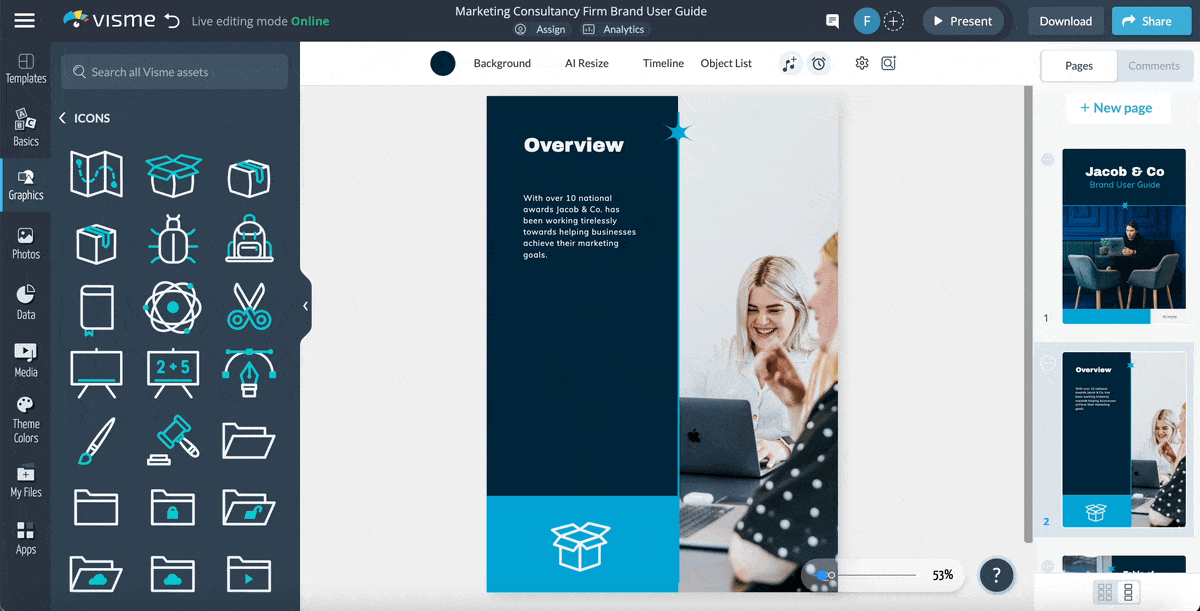
User guides don't have to be boring documents. You can inject personality, creativity and interactivity to make your user guide engaging and memorable.
Ready to ditch the dull and transform your user guide? Our library is packed with millions of stock photos and beautiful 2D and 3D design assets, including icons, illustrations, diagrams, lines, shapes, charts and other data visualization tools to illustrate complex steps or break up text.
Even if you don’t find the perfect image, Visme's AI image generator can transform text into captivating visuals. Choose from a variety of styles, including photos, paintings, drawings, 3D graphics, icons, abstract art, etc. You can also use our AI Image Editing tools and upscaler to add a professional touch to the images you already have on hand.
Maintain a consistent visual style throughout the user guide for a professional look and feel with our Brand Design Tool. You can resize and rearrange design elements, adjust the layout and experiment with various color and font combinations.
For digital guides, you can create a dynamic learning experience by incorporating our wide array of animation and interactive elements. Link pages or slides to objects, incorporate hover effects and clickable pop-ups and use animated icons, illustrations and special effects.

Feel free to add a layer of engagement to your user guide with interactive elements like polls, quizzes, videos or GIFs.
Connect Visme with thousands of popular business productivity tools, such as Salesforce, HubSpot, Monday.com and Slack, so your team can easily find user guides to share with customers.
Once your user guide is ready, you can share it online with a link. You can also download it in multiple formats (PDF, image and PPTX) or generate an HTML code for your website, support page or knowledge base.
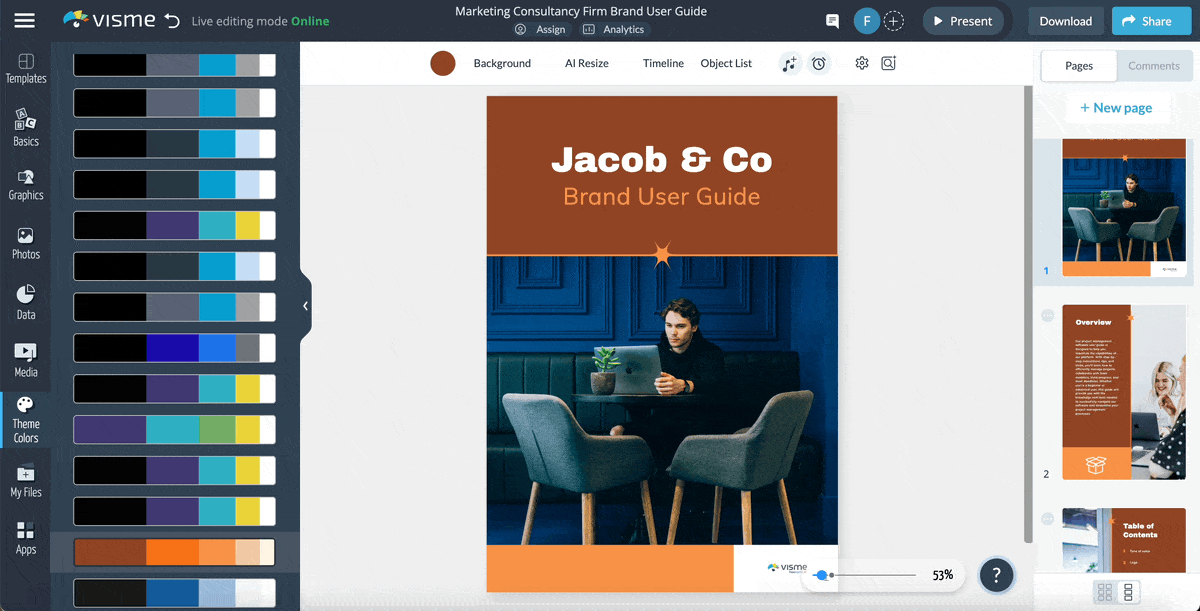
Monitor how your audience interacts with your design using our robust analytics tool. Find out who viewed your design, the visitor's location and IP address, the date/time they viewed it, the time they spent viewing it and the sections they spent the most time on.
Visme provides a full repository of user guide templates to help get your manual off the ground.
However, if you’re running out of time and need to create a user guide quickly, tap into the power of Visme’s AI Document Generator.
Write a detailed prompt describing the type of user guide you need to create, provide more context about the industry or product, select the design, and watch the tool produce a complete user guide with design and content.
Let’s dive into some of the templates you can easily customize.

Elevate your LMS user experience with our intuitive instructional guide manual template. It's user-friendly and has easy-to-follow guides for learners at any level.
The modern template is packed with crucial sections that offer detailed guidance, starting with an engaging introduction to the guide and a brief overview of the platform. It also outlines the categories of users that will benefit from it.
The user guide then dives into the installation instructions and initial configuration, followed by an explanation of the platform’s main features. It also provides valuable information on how users can contact the support team, provide feedback and access regular updates.
This template can be fully customized to suit your needs. You can edit content, apply custom colors, swap out images and add or remove pages.
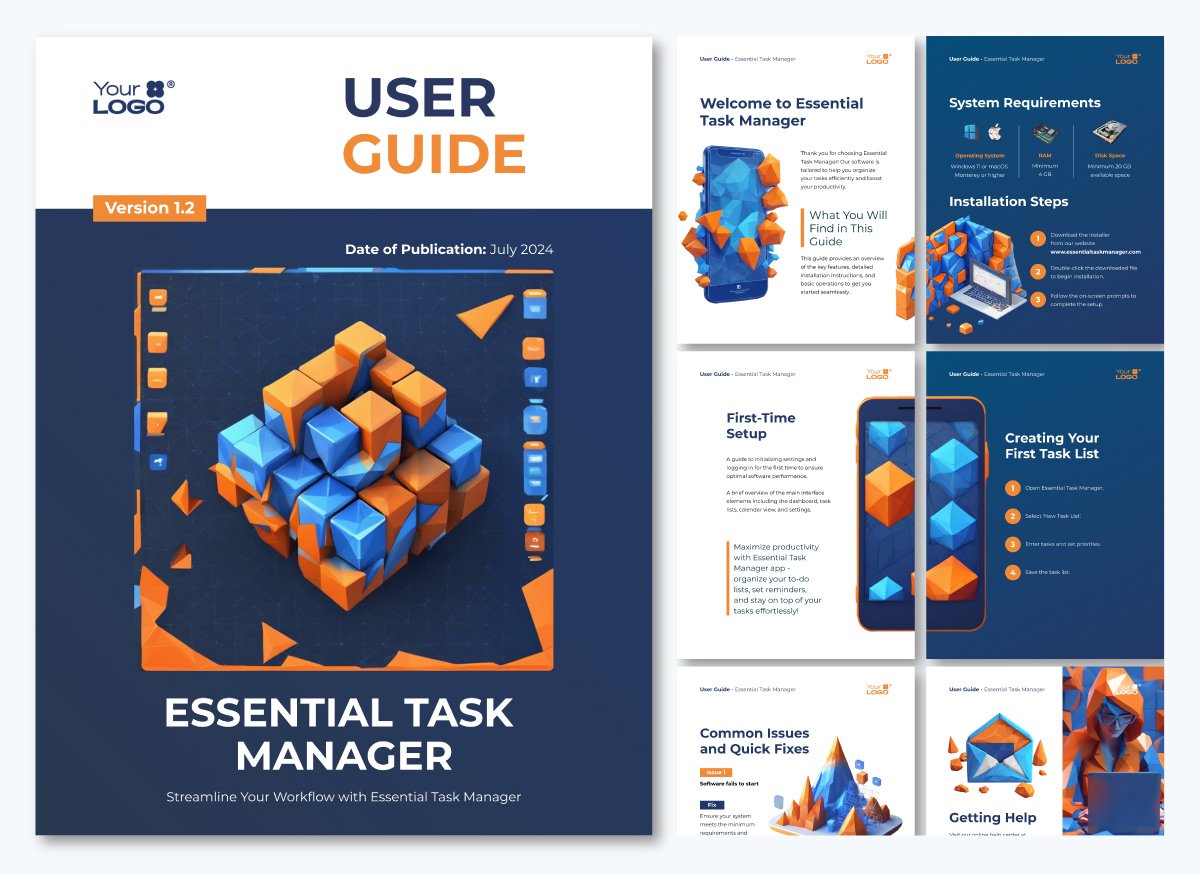
This is one of the best user guide templates you’ll find on the web. It’s designed to help users get the most out of your management software. It covers everything they need to know about using your software, from the initial setup to mastering advanced features.
Starting with the system requirements, installation steps and initial setup, users will learn how to install and configure the product to suit their specific needs. Beyond the initial setup, the guide covers the basic features, common issues and quick fixes. It also highlights instructions on how to check for software updates and the support options available to users, including the knowledgebase, support email and phone.
What makes this user guide stand out is its clear and easy-to-understand language. It has made complex concepts simple, ensuring that even the most technical aspects are understood. And with its logical flow and intuitive organization, users can easily jump to the section they need or follow along from start to finish.

Looking to lighten the load on your customer support team? Check out this awesome self-service guide, packed with vibrant colors, trendy icons, eye-catching mockups and stunning stock photos.
Whether your audience is just starting out or has some experience, this guide will walk them through everything they need to know to use your app. It includes a warm welcome message, an overview of the app and the guide and details on how the application can benefit different user profiles.
You'll also find clear instructions for downloading the app, setting it up, navigating the dashboard and using both basic and advanced features. And that's not all—there are sections dedicated to troubleshooting common issues, seeking assistance, providing feedback, and staying up to date with the latest updates.
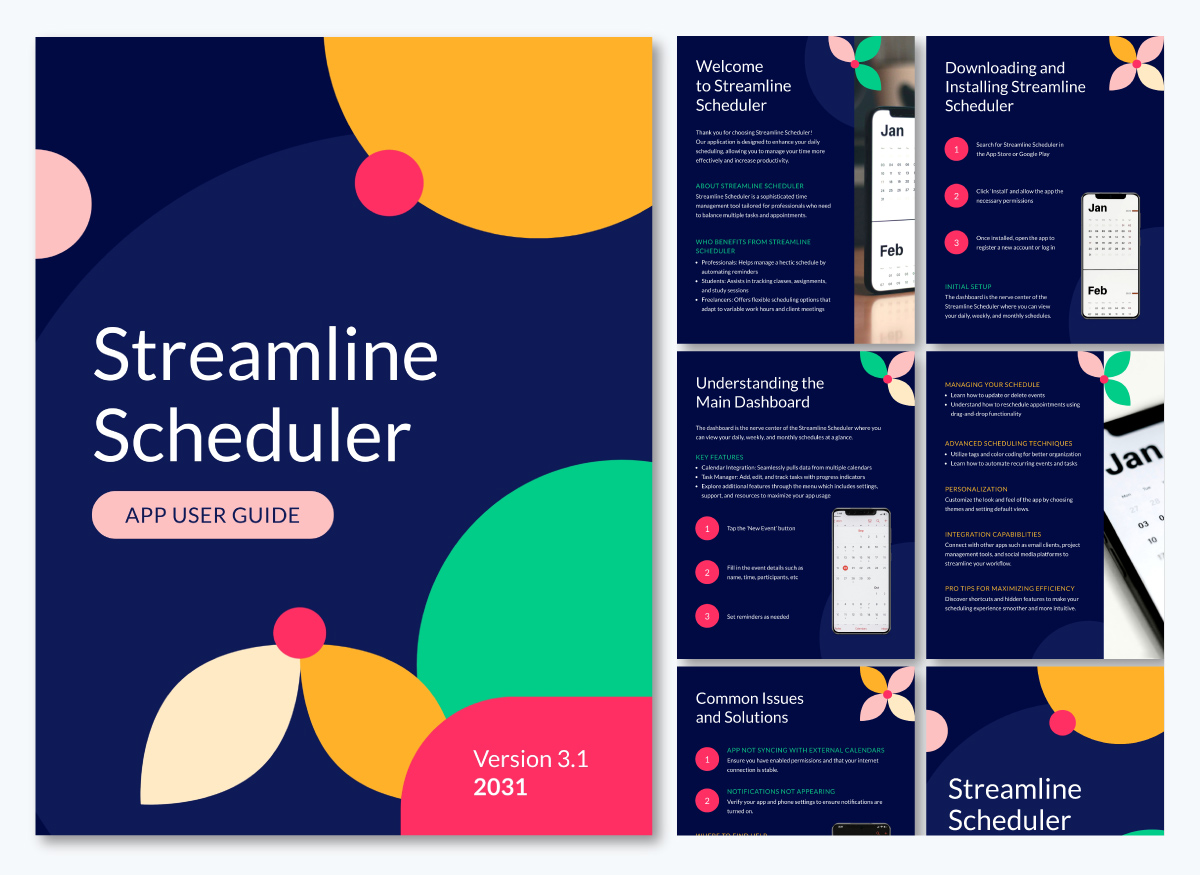
With a creative and vibrant design theme, this application user guide can speed up customer onboarding and product adoption. On the cover page, there’s a bold title, version number and date of release. The rest of the pages capture the product introduction, installation and setup, feature and use cases, troubleshooting tips and other information.
With simple language, bold fonts, short paragraphs, bullet lists and app screenshots, users can quickly scan the content and navigate the application with ease and confidence. You can keep or change the colors to better fit your visual brand style.

Win over your customers and enhance their experience with this captivating dashboard user guide. It provides clear instructions and explanations on how to navigate through the different sections and features of the dashboard.
The guide incorporates app screenshots at relevant points to further aid comprehension and complement the written instructions.
To engage customers, incorporate interactive elements into the guide. For example, you could embed a support video or link to a video on your YouTube or support page. This dynamic element not only makes the learning process enjoyable but also helps users to retain the information better.
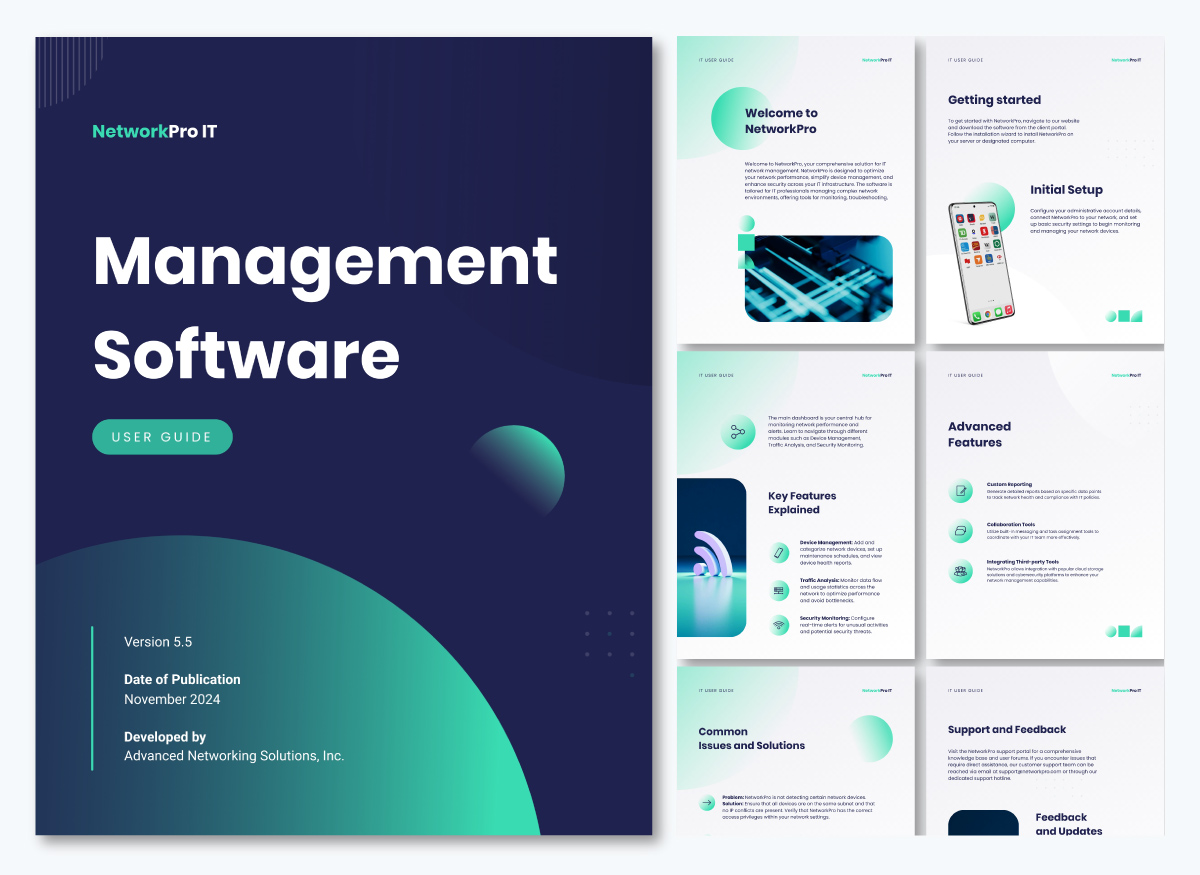
Building a new tech product or adding new features? This incredible IT user guide is the key to reducing product attrition and ramping up customer retention.
Loaded with valuable info, this guide speeds up the time it takes for new customers and existing users to see the full benefits of your product.
New users can dive right in with quick-start sections that walk through the setup and highlight basic features. This user guide example template also covers advanced features, troubleshooting tips, support, feedback and updates.
And when it comes to looks, this user guide has it all—a sleek and stylish design with calming blues, refreshing greens and crisp white accents. The layout is intuitive, with eye-catching icons and stunning visuals that turn every page into a visual treat!
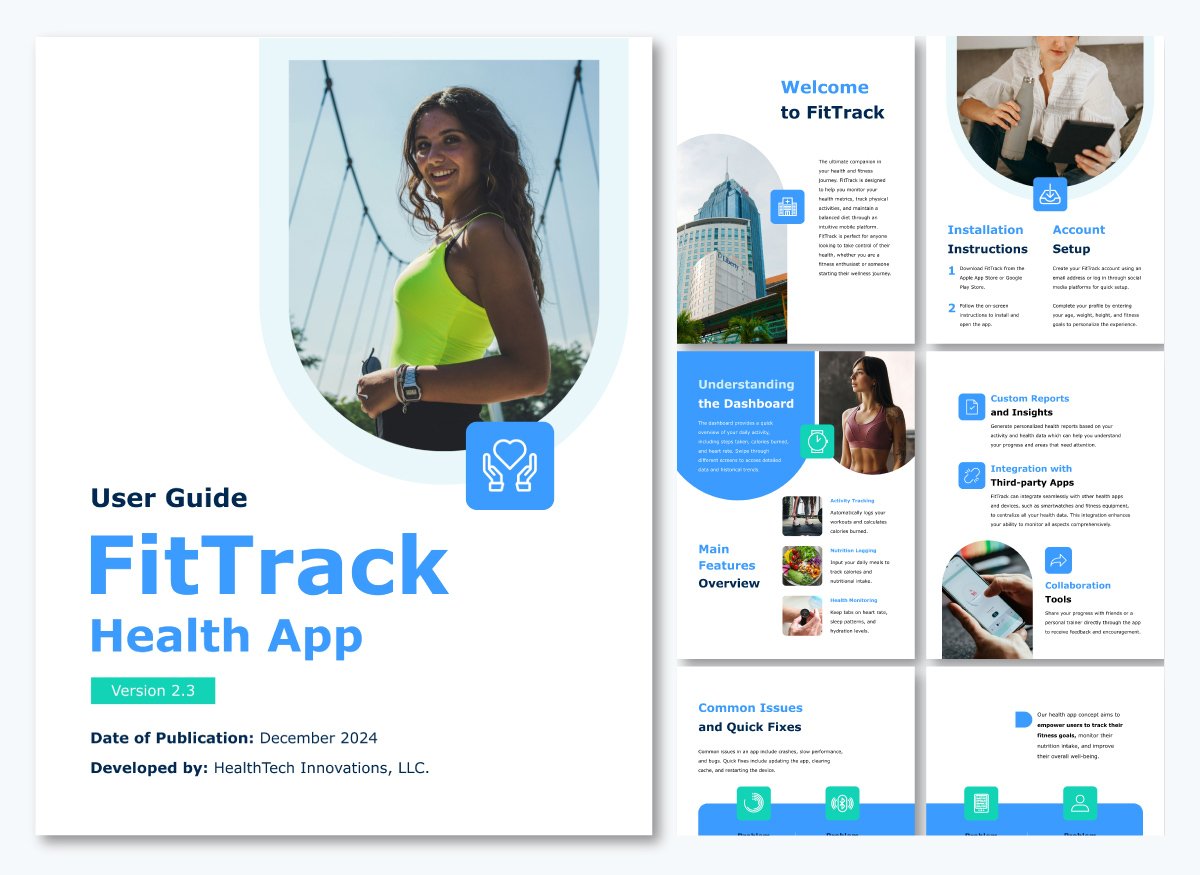
Get ready to supercharge your product experience with our fantastic user guide template! This guide is designed to help users unlock the full potential of our product and achieve their goals in record time.
With a cool white and blue theme, captivating stock photos and sleek icons, this user guide manual template not only looks great but also makes it a breeze to find the information you need. We've used modern fonts to ensure every word is crystal clear and legible. Upload your own images or icons into the guide, and if they need finessing, use our AI Edit Tools.
To cater to your users' diverse needs, you can easily customize it with a few clicks using dynamic fields as well as make this guide accessible in multiple formats. Download it in PDF, image or PPTX format for offline use or generate an online URL for users to access it online.
And that's not all—you have the option to generate an HTML to embed this guide on your support page or knowledgebase.
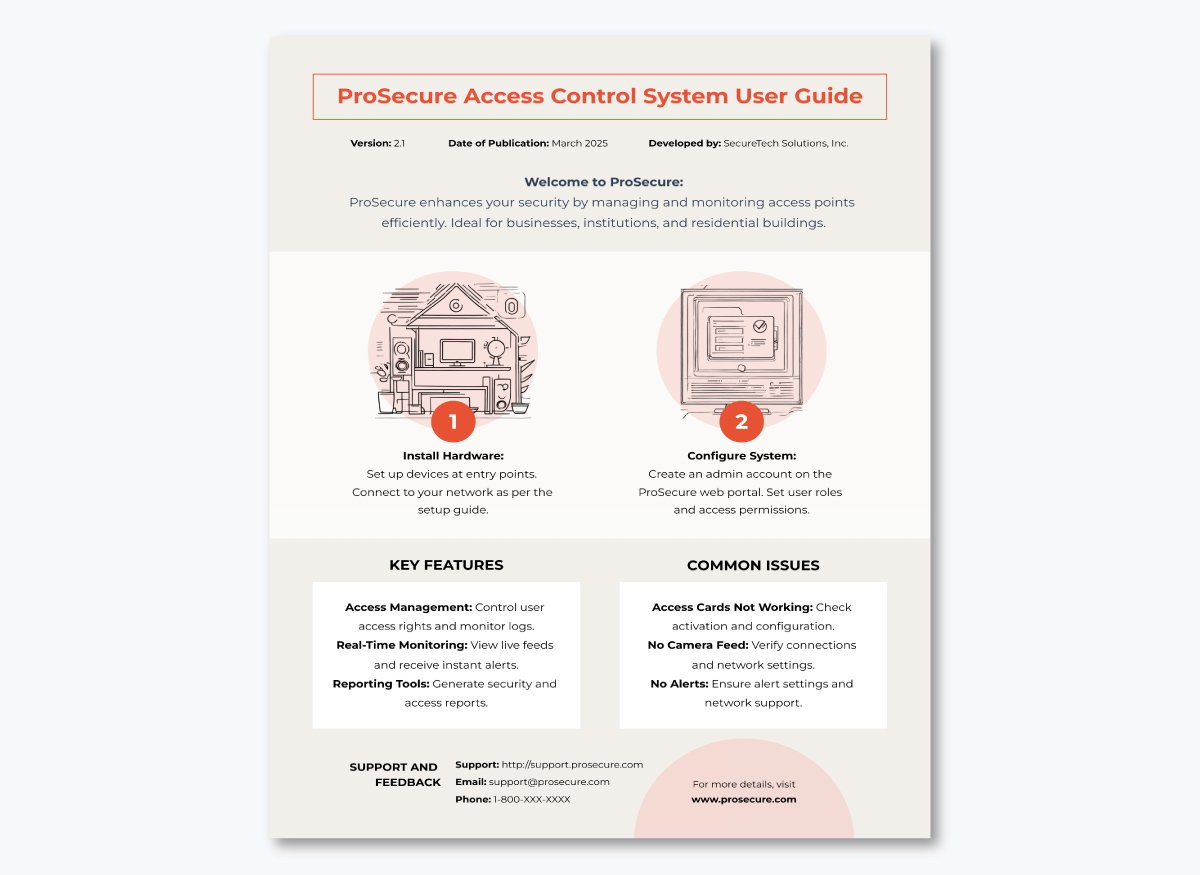
This one-page user guide template is crafted to get users up and running with your product quickly. It distills your product information down to the most essential points, making it easier for users to digest.
You can use it to cover crucial instructions or supplement more detailed manuals. Since users are more likely to read a concise guide, they are more likely to achieve quick wins with your product, boosting their confidence and satisfaction from the get-go. It features a simple two-step setup guide, details of key features, tips for resolving common issues, and all the support and feedback info.

Immerse your users in the world of your amazing product using this visually stunning user guide. Its harmonious blend of striking visuals and an intuitive layout makes learning about our product a breeze. You can customize this user guide to share information about any type of product, whether it's a physical item, a digital service or a software application.
Work together with various teams on design and content using Visme’s collaboration tool. Assign different pages to team members to work on, set deadlines and track completion with our workflow feature.
Once your design is ready, share it with the new customers during onboarding or deploy it as a training tool for new employees. If you’re using it for employee training, export it in SCORM or xAPI format for seamless upload to your learning management system.

This system user guide template is designed to help users quickly and effectively manage and operate their access control systems. It's not just for system administrators and security personnel but also for end-users, empowering everyone to troubleshoot and resolve issues on their own.
The template combines essential content, intuitive design and practical use cases to ensure users can maximize the system's capabilities. You'll love the clean and organized layout, complete with clear sections for quick navigation and helpful diagrams, screenshots and icons to guide users through the system functions visually.
Play around with fonts, color and design, as well as incorporate icons and stock photos from Visme’s library to give it a polished look from start to finish.
Most people don’t read manuals.
In fact, only 25% of consumers say they actually read product manuals.
The remaining 75% either skim or skip them entirely, often because they’re too hard to understand, feel overwhelming or are just plain inaccessible when needed.
To create a user guide worth reading, you have to step into the shoes of your users, anticipate where they might struggle, and give them the kind of guidance that feels like a friendly expert walking them through it.
Here are some proven best practices to help you write a user guide people will actually want to use:
When you’re deeply familiar with a tool, it’s easy to gloss over obvious details. But what’s obvious to you might be completely unfamiliar to someone using your product for the first time.
That’s why one of the most important mindset shifts is to approach your guide like a true beginner.
In a helpful video by the team at Precision Systems, one expert recommends:
“Pretend like you’ve never used the software before. Writing with the mindset of a new user will help identify the areas to focus on… Avoid assuming that everyone shares the same product knowledge that you have and write down even the most obvious of capability and associated process.”
This approach helps you slow down, catch missing steps, and make the experience smoother for someone seeing your interface with fresh eyes. To avoid skipping important details, document what each button does, where to find it and how it fits into a larger workflow.
Clarity comes from precision. Your instructions shouldn’t leave users guessing what to do, where to go or how to proceed, even for advanced features. Instead of vague steps like “customize your settings,” walk them through exactly which menu to open, what button to press and what each option does.
Again, the Precision Systems video emphasizes this point:
“Try to explain things as precisely as possible. The more specific you can be about detailing a feature, the less room for guesswork on the user’s part. Larger features can be broken down into subsections, and those into precise explanations of a single feature.”
Use direct language, name UI elements exactly as they appear, and break down complex workflows into digestible chunks.
The most helpful guide won’t do much good if users can access it. People often skip over user manuals — especially if they’re buried under a pile of marketing materials or hidden deep in a settings menu.
The Manufacturer’s Guide to Developing Consumer Product Instructions stresses the importance of visibility:
“After buying a new product, consumers often want to use it immediately, so written items accompanying the product may seem like a distraction... Locate your instructions so that the effort it takes to seek and notice them is minimized and the effort it takes to avoid and ignore them is maximized. Instructions should be conspicuous and attractive. In other words, they should be immediately obvious to the consumer, and should be clear, bright, and visually pleasing.”
The best practice is to make your instructions easy to spot, appealing to engage with and positioned right where they’re needed most. This could mean embedding them directly in your app interface, linking to them in your onboarding emails, or even a printed guide in the physical packaging.
The only way to know if your guide actually works is to put it in front of real people. Don’t rely on internal reviews or assume your instructions are clear just because they make sense to you.
Instead of asking users to read through your guide and comment, ask them to follow it while using the actual product.
According to the same Manufacturer’s Guide:
“Testing the instructions is important, but testing them on a representative audience is essential if you want your results to have meaning. Include critical subgroups of likely users, such as the elderly and those whose first language is not English.”
Importantly, they add:
“Do not have consumers simply read through the instructions and tell you what they think. They should perform the tasks described in the instructions while using the actual product.”
Pay attention to where users hesitate, backtrack, or get confused in real time. This will quickly reveal what works and what doesn’t. For example, you might spot areas that need clearer steps or better visuals.
| Software | Key Features | Pricing | Best For | Core Uses | G2 Rating |
| Visme | Drag-and-drop editor, customizable templates, data visualization tools, animations, interactivity, AI design tools, brand kits, analytics, real-time collaboration and workflow design tools. | Free; Paid plans from $12.25/mo | Businesses, teams, marketers | Interactive user guides, tutorials, training decks, manuals | 4.5/5 |
| Scribe | Auto-captures workflows, turns clicks into step-by-step guides, screenshots with annotations, editable text, team collaboration, embeddable guides, integrations. | Free; Pro Team from $12/seat/month | Ops, customer support, training | SOPs, onboarding docs, step-by-step product/process guides | 4.5/5 |
| Document360 | Markdown editor, version control, workflow approvals, category manager, custom domains, advanced analytics, search engine, access control, API documentation. | Contact sales | SaaS, product & tech teams | Public or internal knowledge bases, software documentation | 4.7/5 |
| Notion | Real-time collaboration, drag-and-drop blocks, templates, code support, media embeds, kanban/task boards, permissions, AI writing assistant. | Free; Paid from $10 per member/month | Startups, remote teams | Internal guides, SOPs, onboarding documentation | 4.7/5 |
| HelpDocs | SEO-optimized help center, real-time editor, categories and tags, analytics, custom themes, feedback tracking, API, multilingual support, integrations. | From $69/month | SaaS companies | Customer-facing user guides, FAQs, help center articles | 4.3/5 |
| ClickHelp | HTML and WYSIWYG authoring, single-sourcing, conditional content, image and code blocks, customizable outputs (PDF, Word, CHM), reader feedback, translation support. | Free trial, paid from $175/month | Technical writers | Software manuals, product help files, user documentation | 4.8/5 |
| Confluence | Page templates, real-time editing, file versioning, @mentions, Jira integration, macros, page hierarchy, access controls, search functionality. | Free; Paid from $6.40/user/month | Engineering, enterprise teams | Internal wikis, product knowledge bases, user guides | 4.1/5 |
| Adobe RoboHelp | Responsive HTML5 output, conditional tags, advanced CSS customization, topic linking, search auto-complete, multi-device publishing, Git integration. | From $39.99/month | Tech writers, enterprise docs | Software documentation, complex manuals, online help systems | 4.0/5 |
| Loom | Screen + webcam recording, drawing tools, video trimming, CTAs, engagement analytics, viewer insights, password protection, team folders. | Free; Paid from $15/user/month | Customer education, CS teams | Walkthrough videos, visual user guides and onboarding tutorials | 4.7/5 |
Disclaimer: The comparisons and competitor ratings presented in this article are based on features available as of May 15, 2025. We conduct thorough research and draw on both first-hand experience and reputable sources to provide reliable insights. However, as tools and technologies evolve, we recommend readers verify details and consider additional research to ensure the information meets their specific needs.
Let’s take a deeper look at 4 of the best tools for creating user guides.
Okay, full disclosure: I work at Visme—so yeah, a little bias might sneak in. But once you actually get your hands on the tool, you’ll see why I had to include it here.
Visme is an intuitive visual design platform that lets you create both internal and customer-facing assets like user guides, SOPs, manuals, onboarding docs, handbooks and more. I’m not a designer by any stretch, but even I’ve been able to put together stunning, professional-looking documents with it.

You can start from scratch or pick from hundreds of pre-designed templates. And now that Visme has rolled out its AI Designer, it gets even better. It’s easy to whip up polished docs in a fraction of the time.

I tried out the tool and it came back with a list of design options for me to choose from. All that was left for me to do was select my design and customize the text design and other elements to suit my needs.

There’s also an AI Writer to help clean up or expand your copy on the go, and if you need custom visuals, the AI Image Generator and AI Image Editor make that super easy, too.
Working on the user guide with your team? You can invite your team into the workspace, assign roles (view, edit or comment), and even break up the project with workflow tools so everyone knows what they’re responsible for.
But what really makes Visme shine, especially for user manuals, is the interactivity.You can add 2D and 3D animations, hover effects, popups, transitions, links, video, audio, animated icons, and more. It’s everything you need to turn a plain user guide into an engaging, scroll-stopping experience.
Another tool I checked out was Document360. I didn’t request a live demo, so I had to rely on demo videos and online resources to get a feel for how it works. But even without a walkthrough, the platform was pretty intuitive.

One thing I really liked right away was the flexibility it offers when it comes to editing. You get to choose from three editor types depending on your writing style. If you’re into clean, code-friendly writing, the Markdown editor is great. Prefer something more visual? The WYSIWYG editor feels like working in Word. And now there’s an Advanced WYSIWYG editor, which adds even more flexibility.
It also supports AI-powered drafting and has shortcuts that help you create content a lot faster.
Document360 also makes it easy to get started thanks to its pre-built templates. You can import an existing manual from another project or export your current one whenever needed.

Features like Tabs, Quick Insert, and Article Labels help keep things organized. And if you're managing multiple knowledge bases, you can do that from a single portal, each with its own domain and branding.
You can also track historical versions of your articles and revert to previous ones in just a few clicks. There’s even an AI-powered search that makes it easy for users to find exactly what they need, and you can translate your content into 45+ languages.
Document360 offers five pricing tiers: Professional, Business, Enterprise, Enterprise+ and Startup program. However, you need to contact sales for pricing information.
Notion is famous for being an all-in-one productivity and collaboration tool. The marketing team at Visme has been using it for years to manage workflows and coordinate tasks. At this point, it’s basically our second brain.
When it comes to creating wikis, user guides and helpful resources, Notion might not be the first tool that pops into your head. But it does a pretty solid job. You can build clean, searchable, and easy-to-navigate user guides without needing a separate platform.
Here’s a caveat: if you're new to Notion, the layout might seem overwhelming at first. It’s packed with features and options, and you might find yourself going down a rabbit hole of toggles, blocks and databases.
But once you get the hang of how pages, blocks, and links work, it all starts to click and you’ll realize how flexible it really is.
To create a user manual or SOP, you can start with a blank page and turn it into a wiki. From there, build it out however you like using headers, bullet points and toggle lists.
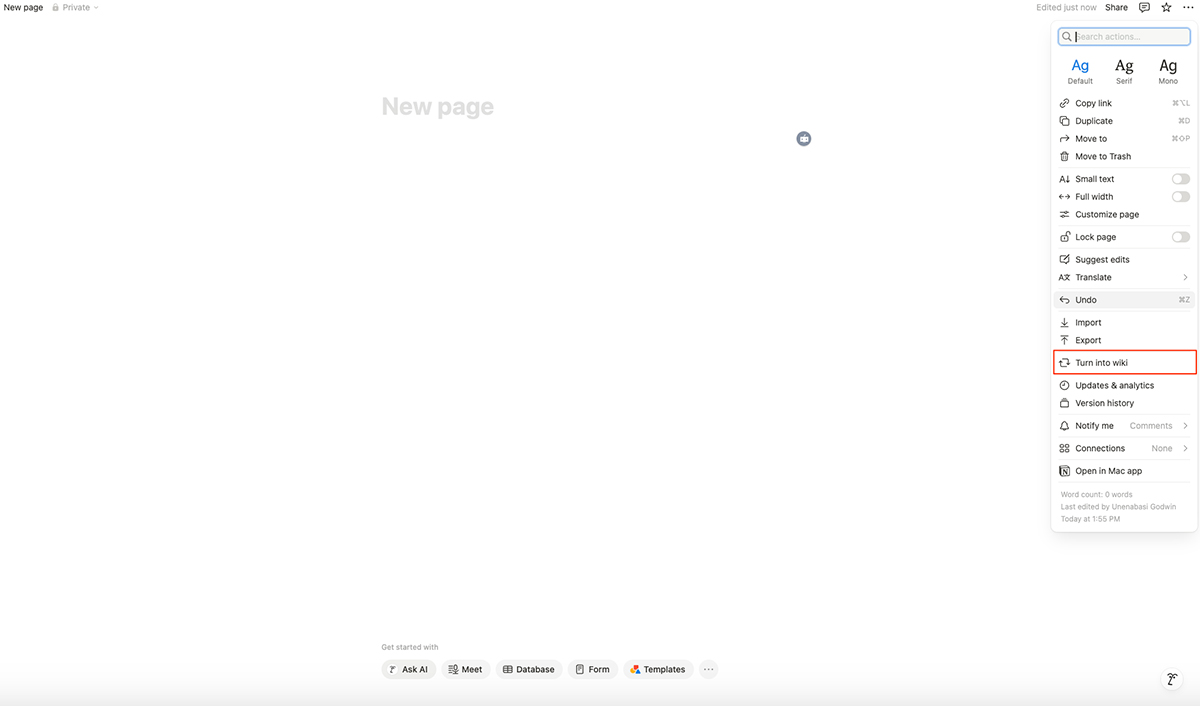
Or if you’d rather not start from scratch, just search “wiki” in the template gallery and pick one that fits your style.

You can also embed images, videos, and Loom tutorials right inside your page. And if you want to link to another process or guide? Just use an @mention to connect everything. Notion also takes care of version control, commenting, and edit history, so your team’s always working with the latest info.
Scribe is also another incredible tool that deserves a spot on this list. I didn’t get to test it hands-on the way I did with some of the other tools. But I did spend time digging through their demo videos, help center, and user resources.
And honestly, Scribe is built for one specific thing: documenting processes fast.
If you’ve ever had to manually write out step-by-step guides with screenshots, annotations, and formatting, you’ll appreciate how Scribe takes that entire workflow and automates it.

Just hit “Record,” walk through your process, and Scribe turns your clicks and keystrokes into a clean, visual guide, complete with screenshots and written instructions.
Once your guide is ready, you can go in and tweak the wording, blur out sensitive data or drop in notes. Then share it via a link, embed it in your knowledge base, or export it as a PDF. You can even group guides into folders, apply your brand, and collaborate with your team, so everything stays organized and on-brand.

There are two ways to get started: the browser extension or the desktop app. Both are lightweight and easy to use. And if you're on a paid plan, you unlock features like analytics, permissions, custom branding, and integrations with tools like Notion and Confluence.
What’s also great is the versatility. Scribe supports everything from quick internal walkthroughs to customer-facing documentation.
The structure of a user manual typically includes the following sections:
To create a user guide in Word, you can start by following these steps:
A user guide should be written in the second person. This means using pronouns like “you” and “your” to directly address the user and make the instructions clearer and more relatable.
An admin user guide is a document that provides instructions and information for individuals who use administrative functions within a system or application. This guide typically includes details on how to set up and configure various administrative settings, manage user accounts, troubleshoot issues and perform other tasks related to system administration. It has advanced functionalities and settings that regular users might not need to access.
The length of a user guide can vary a lot depending on how complicated the system or app is and how detailed the instructions are. A user guide for simple applications with limited features might be as short as 10-20 pages, while for complex software or systems with extensive features and configurations, the guide could range from 50 to several hundred pages.
The goal of a user guide is to furnish users with instructions and information so they can effectively utilize a product or service. It seeks to help users understand features, fix common problems and enhance their overall experience.
User guides are a staple for organizations of all sizes. They bridge the gap between the product or service and the user, ensuring a smooth and successful user experience.
Investing in user guide templates offers much more than that. They can significantly streamline your onboarding process, enhance your customer success strategies and set your business up for success.
Visme has everything you need to create effective user guides, support documentation, training resources, and all kinds of visual content. Gain access to an extensive library of ready-made templates, a full suite of AI-powered tools, and advanced features such as collaboration, workflow management and interactivity.
Don't miss out—sign up for a free account today or request a demo to uncover all that Visme has to offer!
Design visual brand experiences for your business whether you are a seasoned designer or a total novice.
Try Visme for free